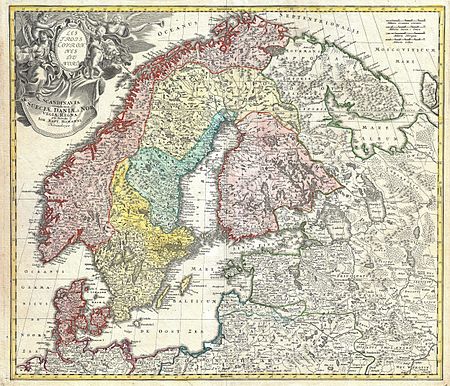 Global Information
Global InformationHistory of Sweden information

| History of Sweden |
|---|
 |
| Timeline |
|
|
| Part of a series on the |
| Culture of Sweden |
|---|
 |
| People |
| Languages |
| Mythology and Folklore |
| Cuisine |
| Festivals |
| Art |
| Literature |
| Music |
| Sport |
|
The history of Sweden can be traced back to the melting of the Northern Polar Ice Caps. From as early as 12000 BC, humans have inhabited this area. Throughout the Stone Age, between 8000 BC and 6000 BC, early inhabitants used stone-crafting methods to make tools and weapons for hunting, gathering and fishing as means of survival.[1] Written sources about Sweden before AD 1000 are rare and short, usually written by outsiders. It is usually accepted that Swedish recorded history, in contrast with pre-history, starts around the late 10th century, when sources are common enough that they can be contrasted with each other.
The modern Swedish state was formed over a long period of unification and consolidation. Historians have set different standards for when it can be considered complete. Some common laws were present from the second half of the 13th century. At this time, Sweden consisted of most of what is today the southern part of the country (except for Scania, Blekinge, Halland and Bohuslän), as well as parts of modern Finland. Over the following centuries, Swedish influence would expand into the North and East.
In the late 14th century Sweden, Denmark and Norway were united in the Kalmar Union. During the following century, a series of rebellions lessened Sweden's ties to the union, sometimes even leading to the election of a separate Swedish king. The fighting reached a climax following the Stockholm Bloodbath in 1520, a mass execution of accused heretics orchestrated by Christian II of Denmark. One of the few members of the most powerful noble families not present, Gustav Vasa, was able to raise a new rebellion and eventually was crowned King in 1523. His reign proved lasting and marked the end of Sweden's participation in the Kalmar Union. Gustav Vasa furthermore encouraged Protestant preachers, finally breaking with the papacy and establishing the Lutheran Church in Sweden, seizing Catholic Church property and wealth.
During the 17th century, after winning wars against Denmark-Norway, Russia, and the Polish-Lithuanian Commonwealth, Sweden emerged as a great power by taking direct control of the Baltic region. Sweden's role in the Thirty Years' War determined the political and religious balance of power in Europe. The Swedish Empire expanded enormously into the modern Estonia and Latvia, northern Germany, and several regions that to this day are part of Sweden.
Before the end of the 17th century, a secret alliance was formed between Denmark-Norway, Polish-Lithuanian Commonwealth, and Russia against Sweden. This coalition acted at the start of the 18th century when Denmark-Norway and the Polish–Lithuanian Commonwealth launched surprise attacks on Sweden. In 1721, Russia and its allies won the war against Sweden. As a result, Russia was able to annex the Swedish territories of Estonia, Livonia, Ingria, and Karelia. This effectively put an end to the Swedish Empire, and crippled her Baltic Sea power. Sweden joined in the Enlightenment culture of the day in the arts, architecture, science, and learning. Between 1570 and 1800, Sweden experienced two periods of urban expansion. Finland was lost to Russia in a war in 1808–1809.
In the early 19th century, Finland and the remaining territories outside the Scandinavian Peninsula were lost. Sweden's last war was the Swedish–Norwegian War (1814). Sweden was victorious in this war, leading to the Danish king being forced to cede Norway to Sweden. Norway was then forced to enter into a personal union with Sweden that lasted until 1905. Since 1814, Sweden has been at peace, adopting a non-aligned foreign policy in peacetime and neutrality in wartime. During World War I, Sweden remained neutral, but let the Germans travel in the country. Post-war prosperity provided the foundations for the social welfare policies characteristic of modern Sweden. During World War II, Sweden once again remained neutral, avoiding the fate of occupied Norway.
The country attempted to stay out of alliances and remain officially neutral during the entire Cold War, and declined to join NATO. The social democratic party held government for 44 years (1932–1976). The 1976 parliamentary elections brought a liberal/right-wing coalition to power. During the Cold War, Sweden remained neutral. Sweden joined NATO in 2024 as a response to the 2022 Russian invasion of Ukraine.
- ^ "History of Sweden – more than Vikings | Official site of Sweden". sweden.se. 3 December 2015. Archived from the original on 3 September 2019. Retrieved 31 March 2020.